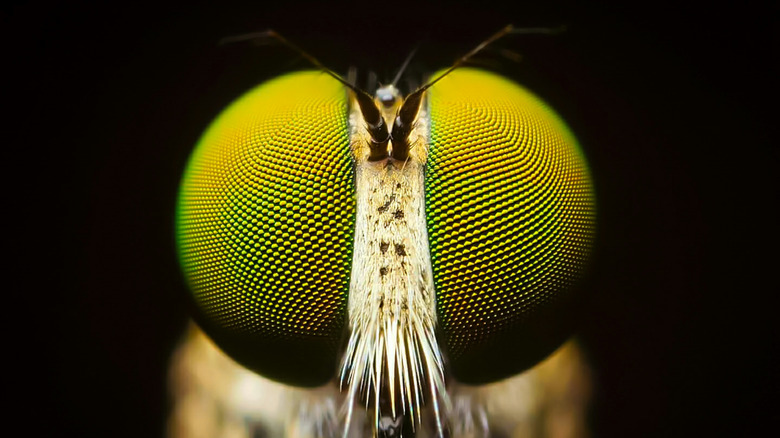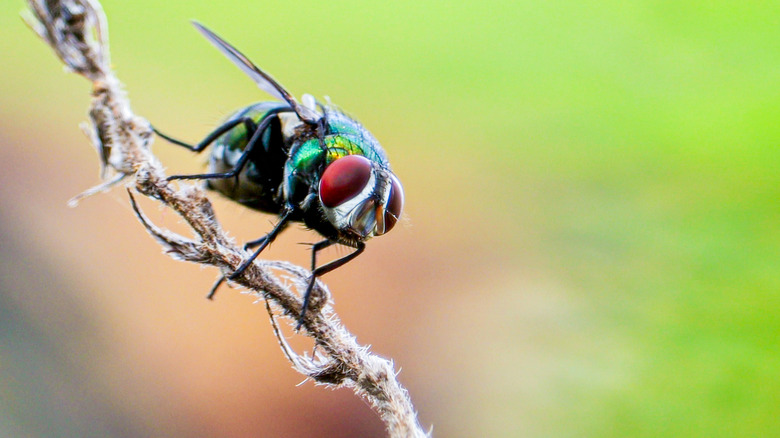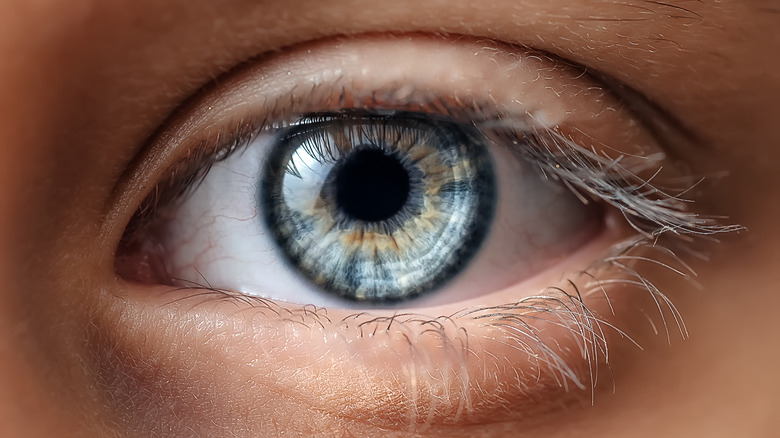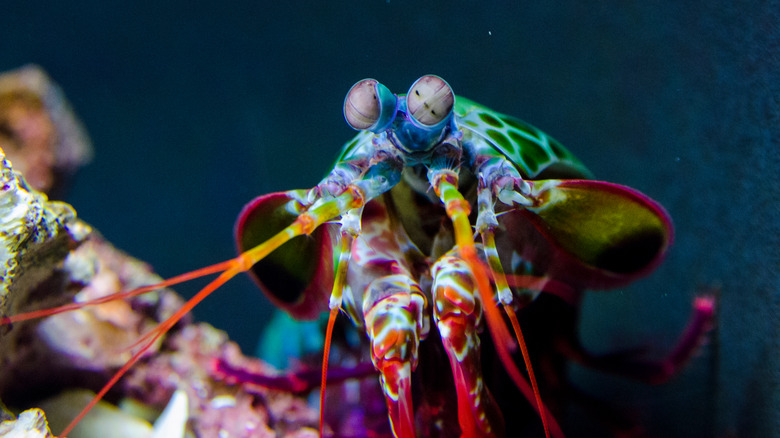This Is What The Compound Eye Of A Fly Actually Sees
It's tough to find a fan of flies. As some of the world's most common pests, flies seem to subsist entirely on the most disgusting refuse on earth — from garbage to dung to rotting carcasses. Seeing a fly inside the house instantly brings to mind their foul appetite. But flies, like many bugs, are also fascinating little creatures with complex anatomy. Take, for instance, their signature pair of compound eyes (via Ask an Entomologist).
One of the defining features of flies, the compound eye is a special organ commonly found in arthropods — the wide, wide world of invertebrates that includes crustaceans, arachnids, and insects. Flies in the order Diptera have massive compound eyes, sometimes so large that they take up most of the space on their heads (like the aptly named big-headed fly). But they're not just bigger eyeballs. The fly's compound eyes comprise an array of tiny sensors called "ommatidia," which means their sight is completely different from ours. Whether their sight is better may be up for debate.
Through the eyes of a fly
Ommatidia — the tons of tiny lenses flies use to see — are bunched together in a globular shape to form a compound eye. The large, round shape of their eyes gives flies an almost 360-degree view of their surroundings. According to Ask an Entomologist, each ommatidium is "kind of like an eyeball," in that it possesses a corneal lens to focus light and pigments that sense color. Having such large eyes with wide panoramic vision is what enables flies to see all around them so well.
The fly's supersized compound eyes help them catch prey and avoid our frustrated swipes at them, but another key feature gives the fly an advantage: "slow-motion" vision. The BBC describes the quickest fly's ability to process images as "more than six times faster" than that of humans. Every passing moment in the world of a fly is several times slower than what we perceive. So, when you're creeping up behind the fly buzzing around your kitchen — swatter in hand, ready to strike — the fly sees you behind its back — and probably saw you before you even noticed it was there.
Is a compound eye better?
Compound eyes are great for a little bug like a fly. With the hundreds or thousands of ommatidia working together in their eyes, flies don't need to turn their heads to see around them. According to Ask an Entomologist, they have excellent peripheral vision, fewer blind spots, and a better range of focus across their many lenses. Of course, there's also the fly's almost supernatural ability to see in slow motion. These features have even inspired scientists and engineers to design cameras that mimic these insects' unique eyes, allowing humans to create surveillance systems that literally act as the proverbial fly on the wall.
All that ommatidia and slow-mo vision make a fly's eyes seem impossible to beat. But compared to a human eye, flies have had to make some compromises in order to see as well as they do. For one, our two human eyes take up far less space on our heads than a fly's do. The resolution we get through just two eyes is far higher than what two ommatidia provide for a fly. In order to up the quality of the image that a fly can see, the compound eye has to add more and more ommatidia. House flies have around 3,500 ommatidia while dragonflies can have 30,000, per Ask an Entomologist. And, while human eyes can focus, compound eyes don't have that ability. Flies have to move their entire bodies up close or far away from objects, prey, or mates to see them more clearly.
What else has compound eyes?
Our immediate image of a fly is that they are annoying and we don't want them landing on our food — though some of these pests are actually dangerous insects. But not all flies are pests; some are pollinators and others play important roles in natural decomposition. As it turns out, compound eyes are just as useful in performing these other jobs as they are in dodging our fly swatters. According to Ask an Entomologist, organisms with compound eyes make up a wide population of arthropods, from mantis shrimp to honeybees. Their eyes help them see ultraviolet (UV) light to better spot flowers and potential mates. And when you're zooming around at such high speeds, it's crucial to be able to pick up subtle details in an instant.
Some insects like dragonflies have differently colored parts of their compound eyes, which may help with shading their eyes from harsh sunlight. Others have eyes with color bands and specific tints that entomologists theorize may help attract mates or better distinguish prey from their natural surroundings. Yet others have dramatic, long eyestalks or lose the ability to see certain colors. Clearly, evolution has ensured that whatever types of eyes these creatures are working with, it enables their ability to not only see but survive and thrive.



